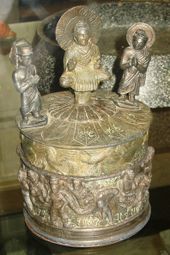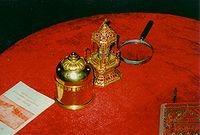
Kanishka casket
Encyclopedia

Kanishka
Kanishka ) was an emperor of the Kushan Empire, ruling an empire extending from Bactria to large parts of northern India in the 2nd century of the common era, and famous for his military, political, and spiritual achievements...
, in 127 CE
127
Year 127 was a common year starting on Tuesday of the Julian calendar. At the time, it was known as the Year of the Consulship of Rufus and Squilla...
.
History and description
It was discovered in a deposit chamber under the monumental Kanishka stupaKanishka stupa
The Kanishka stupa was a monumental stupa established by the Kushan king Kanishka during the 2nd century CE in today's Shah-ji-Dheri on the outskirts of Peshawar, Pakistan....
(described by Chinese pilgrims in the 7th century as the tallest stupa in all India), during the archeological excavations in 1908-1909 in Shah-ji-Dheri on the outskirts of Peshawar
Peshawar
Peshawar is the capital of Khyber-Pakhtunkhwa and the administrative center and central economic hub for the Federally Administered Tribal Areas of Pakistan....
. It is said to have contained three bone fragments of the Buddha, which were forwarded to Burma by the British following the excavation, where they still remain.
The casket is today at the Peshawar Museum
Peshawar Museum
The Peshawar Museum is a Museum situated in the historic city of Peshawar, Khyber Pakhtunkhwa, Pakistan.-Introduction:Situated between the old Deans Hotel and the Old city, about five minutes walk from Jail Bridge and the Railway station....
, and a copy is in the British Museum
British Museum
The British Museum is a museum of human history and culture in London. Its collections, which number more than seven million objects, are amongst the largest and most comprehensive in the world and originate from all continents, illustrating and documenting the story of human culture from its...
. The casket is dedicated in Kharoshthi. The inscription reads:
- "(*mahara)jasa kanishkasa kanishka-pure nagare aya gadha-karae deya-dharme sarva-satvana hita-suhartha bhavatu mahasenasa sagharaki dasa agisala nava-karmi ana*kanishkasa vihare mahasenasa sangharame"
- "In the acceptance (i.e. for the acceptance) of the Sarvāstivādin teachers, this perfume box is the meritorious gift of Mahārāja Kanishka [ . . . jasa Kani] in the city of Kanishkapura [Kanishkapure nagare]. May (it) be for the welfare and happiness of all beings. . . . sa, the superintendent of construction of the refectory in Kanishka's vihāra [nashkasa vihare], in Mahāsena's saṁghārāma [Mahasenasa saṁgharame]."
Originally it was believed, that the text is signed by the maker, a Greek artist named Agesilas, who oversaw work at Kanishka's stupa
Stupa
A stupa is a mound-like structure containing Buddhist relics, typically the remains of Buddha, used by Buddhists as a place of worship....
s (caitya), confirming the direct involvement of Greeks with Buddhist realizations at such a late date: "The servant (dasa
Dasa
Dasa is a term used with the primary meaning 'enemy', especially relating to tribes identified as the enemies of the Indo-Aryan tribes in the Rigveda....
) Agisalaos, the superintendent of works at the vihara of Kanishka in the monastery of Mahasena" ("dasa agisala nava-karmi ana*kaniskasa vihara mahasenasa sangharame"). However, a recent cleaning of the casket had shown that the old reading was not accurate. Instead, the name is to be read agnisala, which is the refectory
Refectory
A refectory is a dining room, especially in monasteries, boarding schools and academic institutions. One of the places the term is most often used today is in graduate seminaries...
of the monastery.
The lid of the casket shows the Buddha on lotus pedestal, and worshipped by Brahma
Brahma
Brahma is the Hindu god of creation and one of the Trimurti, the others being Vishnu and Shiva. According to the Brahma Purana, he is the father of Mānu, and from Mānu all human beings are descended. In the Ramayana and the...
and Indra
Indra
' or is the King of the demi-gods or Devas and Lord of Heaven or Svargaloka in Hindu mythology. He is also the God of War, Storms, and Rainfall.Indra is one of the chief deities in the Rigveda...
.
The edge of the lid is decorated by a frieze of flying geese, or Hamsa
Hamsa bird
The Hamsa is an aquatic bird, often considered to be a goose or sometimes a swan. It is used in Indian and Southeast Asian culture as a symbol and a decorative element.-Identification :...
, symbolizing the travel of departing souls and the removel from samsara
Samsara
thumb|right|200px|Traditional Tibetan painting or [[Thanka]] showing the [[wheel of life]] and realms of saṃsāraSaṅsāra or Saṃsāra , , literally meaning "continuous flow", is the cycle of birth, life, death, rebirth or reincarnation within Hinduism, Buddhism, Bön, Jainism, Sikhism, and other...
. Some of the geese have a wreath of victory in their beak.

A garland, supported by cherubs
CHERUBS
CHERUBS is a Non-Profit Organization. It was founded in February, 1995 for families of children born with Congenital Diaphragmatic Hernia, a severe and often lethal birth defect. It was founded and currently led by Dawn M...
goes around the scene in typical Hellenistic style.
The relics themselves were forwarded to Burma by the British in 1910 in order to safeguard them. They are today visible in Mandalay
Mandalay
Mandalay is the second-largest city and the last royal capital of Burma. Located north of Yangon on the east bank of the Irrawaddy River, the city has a population of one million, and is the capital of Mandalay Region ....
. The three fragments of bone are believed to be true relics of Gautama Buddha.

